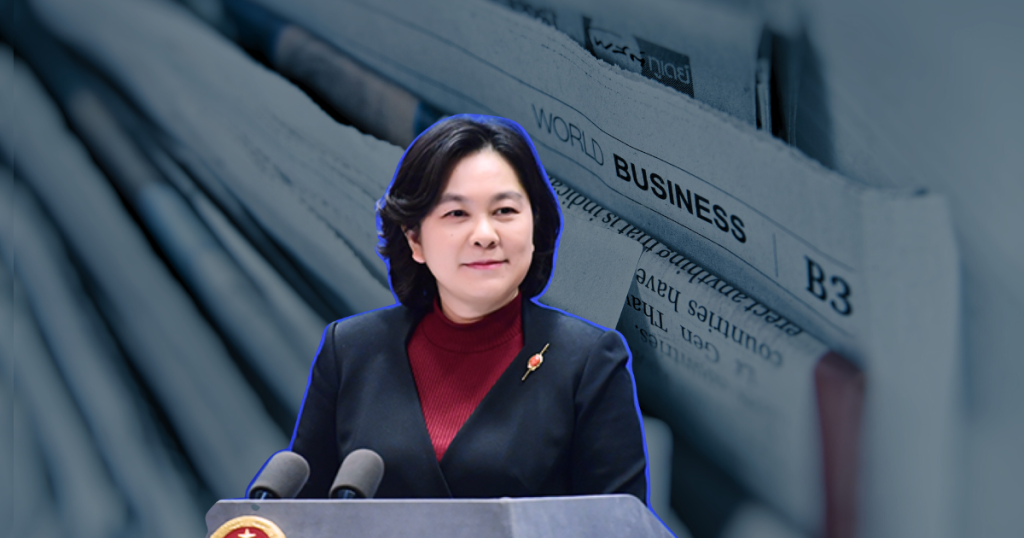China’s concept of a free press

By Manuel Mogato | Date 03-29-2024
MANILA — A Chinese diplomat said the Philippines would take journalists every time it delivers supplies to a grounded vessel in the Second Thomas Shoal and use them as propaganda tools to malign Beijing’s image as aggressors in the disputed sea.
Hua Chunying, the assistant foreign minister who serves as its spokeswoman, also accused foreign and local journalists of manipulating their videos and still images to show China’s coercive activities in the West Philippine Sea.
Press groups, including the Foreign Correspondents Association of the Philippines (FOCAP), immediately lashed back at the Chinese foreign ministry and embassy in Manila for questioning local and foreign journalists’ credibility and impartiality.
Some of FOCAP’s member organizations were China-based news agencies, newspapers, and broadcast networks.
Hua might think the Philippine Coast Guard has been instructing journalists on what images to take as it imposes an embargo and allows the media to air when they return to shore.
There was an embargo on still images and videos taken during the rotation and resupply missions, but there were no orders to manipulate the images.
The government does not restrict media reporting in the West Philippine Sea except on issues involving apparent national security issues.
The embargo was imposed to ensure less sensitive images inside the vessel would be taken, but everything was allowed.
Hua may need to learn how the free and independent media organizations outside China operate.
Perhaps Hua is used to how the Chinese government imposed tight control on its press, turning them into mouthpieces and propaganda tools.
The Chinese Communist Party-controlled English-language newspaper has also been an effective “attack dog” to spread disinformation and discredit the Philippines as a “troublemaker” in the region.
Hua’s statement about the journalists’ role in the Philippines’ routine rotation and resupply missions to a stranded naval vessel on Second Thomas Shoal betrays how China used its press to manipulate information.
Hua might think the Philippine government, through its Coast Guard, allows journalists to join the rotation and resupply missions if they agree to manipulate their images.
The Coast Guard has allowed local and foreign journalists to board its vessels and to freely shoot images of what happened in the disputed shoal.
It is part of the Philippines’ new “assertive transparency” policy, a departure from the previous administration’s appeasement policy.
Rodrigo Duterte, who considered Xi Jinping, was not transparent enough to show how China bullied the Philippines in the West Philippine Sea.
It may be true that the Department of Foreign Affairs had lodged hundreds of diplomatic protests against China for violating its exclusive economic zone (EEZ) during the six years that Duterte was in power.
Still, the media images made it easier for the public to understand the situation.
Under Ferdinand Marcos Jr’s government, it was not only the Filipinos but the whole world knew about the aggressive actions made by the Chinese Coast Guard on a wooden-hulled boat from the Philippines, blasting it with highly pressurized water from cannons.
The boat was crippled, and some of its crew were injured from the shattered windshield.
China’s press parroted the foreign ministry and embassy’s statements that the Philippines intruded into its “claimed” territory based on the historical ten-dash-line.
China’s claim was baseless and illogical. It was excessive and not by international laws, particularly the 1982 United Nations Convention on the Law of the Sea (UNCLOS).
The 2016 Permanent Court of Arbitration (PCA) ruling in the Hague further nullified China’s historical ten-dash-line claim.
Thus, China is holding the South China Sea’s fine sand in its claim. But China, as articulated and amplified by its press, will have none of this.
China continued to insist on its historical claim over the strategic waterway, where $3 trillion of seaborne trade passed annually.
On the other hand, the Philippines has cleaver exclusive jurisdiction and sovereign rights over some of the reefs, atolls, and shoals in the South China Sea because these are within its 200 nautical mile exclusive economic zone (EEZ).
Why can’t China recognize the Philippines has sovereign rights and jurisdiction over areas within its EEZ?
China’s press also refused to recognize the Philippines’ EEZ rights.
A free and independent press must truthfully report the facts and should not be dictated by the government.
But that’s not how China’s press works.
Tags: Security
